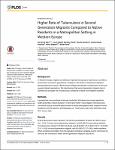Higher Rate of Tuberculosis in Second Generation Migrants Compared to Native Residents in a Metropolitan Setting in Western Europe
Marx, Florian M.
Fiebig, Lena
Hauer, Barbara
Brodhun, Bonita
Glaser-Paschke, Gisela
Magdorf, Klaus
Haas, Walter
Background: In Western Europe, migrants constitute an important risk group for tuberculosis, but little is known about successive generations of migrants. We aimed to characterize migration among tuberculosis cases in Berlin and to estimate annual rates of tuberculosis in two subsequent migrant generations. We hypothesized that second generation migrants born in Germany are at higher risk of tuberculosis compared to native (non-migrant) residents. Methods: A prospective cross-sectional study was conducted. All tuberculosis cases reported to health authorities in Berlin between 11/2010 and 10/2011 were eligible. Interviews were conducted using a structured questionnaire including demographic data, migration history of patients and their parents, and language use. Tuberculosis rates were estimated using 2011 census data. Results: Of 314 tuberculosis cases reported, 154 (49.0%) participated. Of these, 81 (52.6%) were first-, 14 (9.1%) were second generation migrants, and 59 (38.3%) were native residents. The tuberculosis rate per 100,000 individuals was 28.3 (95CI: 24.0–32.6) in first-, 10.2 (95%CI: 6.1–16.6) in second generation migrants, and 4.6 (95%CI: 3.7–5.6) in native residents. When combining information from the standard notification variables country of birth and citizenship, the sensitivity to detect second generation migration was 28.6%. Conclusions: There is a higher rate of tuberculosis among second generation migrants compared to native residents in Berlin. This may be explained by presumably frequent contact and transmission within migrant populations. Second generation migration is insufficiently captured by the surveillance variables country of birth and citizenship. Surveillance systems in Western Europe should allow for quantifying the tuberculosis burden in this important risk group.
Dateien zu dieser Publikation
Keine Lizenzangabe

